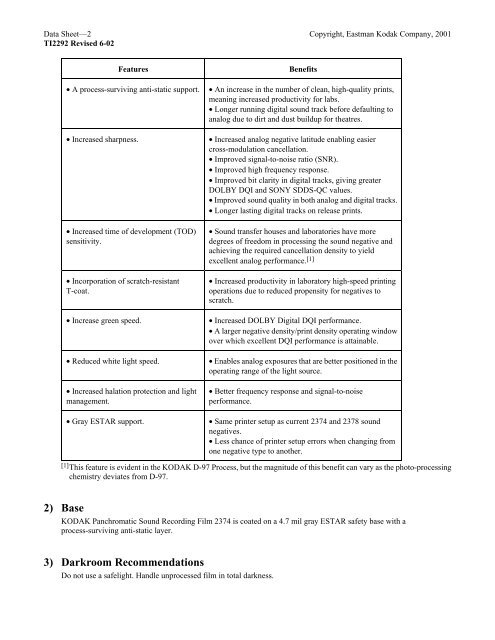KODAK Panchromatic Sound Recording Film 2374 (ESTAR)
KODAK Panchromatic Sound Recording Film 2374 (ESTAR)
KODAK Panchromatic Sound Recording Film 2374 (ESTAR)
Create successful ePaper yourself
Turn your PDF publications into a flip-book with our unique Google optimized e-Paper software.
Data Sheet—2 Copyright, Eastman Kodak Company, 2001<br />
TI2292 Revised 6-02<br />
Features Benefits<br />
• A process-surviving anti-static support. • An increase in the number of clean, high-quality prints,<br />
meaning increased productivity for labs.<br />
• Longer running digital sound track before defaulting to<br />
analog due to dirt and dust buildup for theatres.<br />
• Increased sharpness. • Increased analog negative latitude enabling easier<br />
cross-modulation cancellation.<br />
• Improved signal-to-noise ratio (SNR).<br />
• Improved high frequency response.<br />
• Improved bit clarity in digital tracks, giving greater<br />
DOLBY DQI and SONY SDDS-QC values.<br />
• Improved sound quality in both analog and digital tracks.<br />
• Longer lasting digital tracks on release prints.<br />
• Increased time of development (TOD)<br />
sensitivity.<br />
• Incorporation of scratch-resistant<br />
T-coat.<br />
• <strong>Sound</strong> transfer houses and laboratories have more<br />
degrees of freedom in processing the sound negative and<br />
achieving the required cancellation density to yield<br />
excellent analog performance. [1]<br />
• Increased productivity in laboratory high-speed printing<br />
operations due to reduced propensity for negatives to<br />
scratch.<br />
• Increase green speed. • Increased DOLBY Digital DQI performance.<br />
• A larger negative density/print density operating window<br />
over which excellent DQI performance is attainable.<br />
• Reduced white light speed. • Enables analog exposures that are better positioned in the<br />
operating range of the light source.<br />
• Increased halation protection and light<br />
management.<br />
• Better frequency response and signal-to-noise<br />
performance.<br />
• Gray <strong>ESTAR</strong> support. • Same printer setup as current <strong>2374</strong> and 2378 sound<br />
negatives.<br />
• Less chance of printer setup errors when changing from<br />
one negative type to another.<br />
[1] This feature is evident in the <strong>KODAK</strong> D-97 Process, but the magnitude of this benefit can vary as the photo-processing<br />
chemistry deviates from D-97.<br />
2) Base<br />
<strong>KODAK</strong> <strong>Panchromatic</strong> <strong>Sound</strong> <strong>Recording</strong> <strong>Film</strong> <strong>2374</strong> is coated on a 4.7 mil gray <strong>ESTAR</strong> safety base with a<br />
process-surviving anti-static layer.<br />
3) Darkroom Recommendations<br />
Do not use a safelight. Handle unprocessed film in total darkness.

















